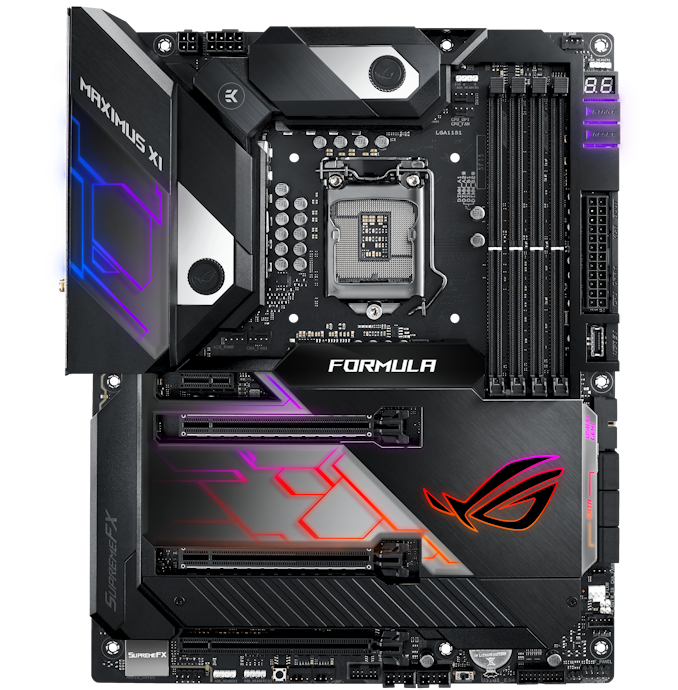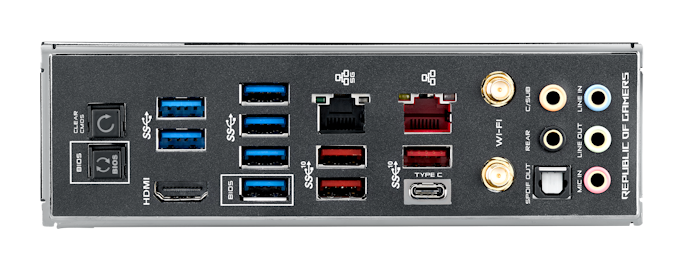Intel Z390 Motherboard Overview: 50+ Motherboards Analyzed
by Ian Cutress & Gavin Bonshor on October 8, 2018 10:53 AM EST- Posted in
- Motherboards
- Intel
- MSI
- Gigabyte
- ASRock
- EVGA
- Asus
- NZXT
- Supermicro
- Z390
ASUS ROG Maximus XI Formula
Another high-end board on the Z390 chipset from ASUS is the ROG Maximus XI Formula which has a similar rear panel cover as the Maximus XI Code along with what looks to be a near identical PCIe slot layout. Other similarities stretch to the use of a PCB cover which looks to have a little more flair and more RGB than the Code, but from a quick glance, the entirety of what's visible PCB wise looks to be identical to the ROG Maximus XI Code; this is not necessarily a bad thing. The biggest difference and impressive inclusion on the Formula over the Code is the EKWB power delivery water block which allows enthusiasts to hook it up to custom water cooling loops for even lower VRM temps; perfect for users to overclock their processors and NOT have to worry about the quality of the power delivery heatsinks.
The Maximus XI Formula keeps the same power and reset buttons with a LED debug in the top right corner. There are four RAM slots with support for DDR4-4400 with a maximum capacity of up to 64 GB in total. Built-in into the board is a pair of PCIe 3.0 x4 M.2 slots (one with SATA support and one without) which feature a pair of heatsinks which amalgamate into the boards overall aesthetic. Also present is a total of six SATA ports with support for RAID 0, 1, 5 and 10 arrays.
The board has three full-length PCIe 3.0 slots which allow for two-way SLI and three-way CrossFire multi-graphics card support at x16/x0/x4 and x8/x8/x4 respectively much like the majority of the Maximus XI boards including the Hero, Hero (Wi-Fi) and Code. This also stretches to the onboard audio and networking with a Supreme-FX S1220 8-channel HD audio codec and a single Intel I219V Gigabit NIC on the rear panel.
With a host of quality connections integrated, there's dual LAN with one port being powered by an Aquantia AC111C 5 G NIC and the second by an Intel I219V Gigabit controller. Wireless networking is provided by a Wave 2 2T2R 802.11ac Wi-Fi adapter and a single HDMI 1.4b video output. The same pair of buttons consisting of a BIOS Flashback and clear CMOS is featured much like the Code, and the onboard audio is controlled by a gaming-focused SupremeFX S1220A HD audio codec. Last but not least is USB support, with three USB 3.1 Gen2 Type-A ports, a single USB 3.1 Gen2 Type-A port and a hefty six USB 3.0 Type-A ports completing a packed rear IO.
The ASUS ROG Maximus XI Formula has an unknown price as of yet, but is one of the top ASUS Z390 boards at launch with a clear focus on gaming based features and enthusiast grade components such as the EKWB made power delivery heatsink. The Formula is primarily targeted at gamers and enthusiasts with overclocking as a focus and the inclusion of 5 Gigabit LAN sets this board apart from the most of the Maximus XI range.












79 Comments
View All Comments
gavbon - Tuesday, October 9, 2018 - link
Thank you Hickory, will update now; this information wasn't available to us at the timebill44 - Tuesday, October 9, 2018 - link
All this boards, but only 1 with Thunderbolt 3. Looks like Thunderbolt 3 is dead (free or not).Type C ports and HDMI 2.0 is in short supply too.
Hopefully next year, we can have two or more USB C (maybe even 3.2), HDMI 2.1, PCIe 4/5 and Thunderbolt 3/4 (Titan Ridge?). Or maybe not, just the same old things hoping for 2020/21.
DanNeely - Tuesday, October 9, 2018 - link
There's no licensing fee for TB, the controller chip itself still costs money (IIRC $20 or $30) and still eats 4 PCIe lanes. Worse, IIRC to make the video out feature work they need to be CPU lanes; meaning that adding it means your main GPU slot is an x8, and the secondary one only x4.gavbon - Tuesday, October 9, 2018 - link
Yeah it's a case of certain vendors opting to dismiss including TB3 ports, which only seems sensible on mini-ITX boards where PCIe lanes aren't too much of an issue. Consumer choice is important though and I'm still glad ASRock has included it; it could be a key buying decision for some!gamingkingx - Friday, October 12, 2018 - link
Just too bad it is only wired as a x2.. And it is wired into the chipset as far as I am aware, so you are gonna max out your I/Os pretty fast.bill44 - Wednesday, October 10, 2018 - link
Sure, anything you add will cost something. The are plenty of non-gamers who prefer TB3 vs x16.This also highlights how old current PC architecture is. Either we need more PCIe lanes, or faster lanes. Otherwise, all advances will be hindered.
Up to 6 USB 3.1 Gen 2 ports? You’ be lucky to get 4. Why can’t we have 6 Gen2 ports and the rest Gen1 an no antiquated USB 2.0? PCIe resources.
All new peripherals use Type C, but this boards generally give you only 1 (saving money on redrivers). USB 3.2 (20 Gbps)? When it comes around, ithis too will need more PCIe lanes. M.2. PCIe 3.0 x4? All lanes are maxed out; the only way forward is faster lanes.
In the past, Gigabyte was a TB3 champion including the functionality on many of their boards. Now, not a single one.
Cost saving by motherboard makers? Prioritising gamers? Or simply no demand for TB3.
The outcome is the same.
repoman27 - Thursday, October 18, 2018 - link
Intel merely said that they planned "to make the Thunderbolt protocol specification available to the industry under a nonexclusive, royalty-free license" sometime this year. This hasn't happened yet, and is referring to the protocol spec, not the silicon that Intel produces. If and when they decide to do this, ASMedia or whoever could then begin development of their own Thunderbolt controllers. This means that third-party controllers probably won't appear in shipping products until sometime in 2023.As for the currently available Thunderbolt 3 controllers, tray prices range from $6.45 to $9.10. But you also need a USB Type-C and PD controller, power switch, and high-speed mux which runs around $4.59, plus the connector and a few other bits. I don't believe Intel charges a royalty on finished Thunderbolt products, but they do require licensing and certification which are paid for by the OEM and may add significant cost to relatively low-volume products.
AFAIK, Windows PCs are still required to connect Thunderbolt controllers via the PCH. Apple is the only one using PEG lanes for Thunderbolt, and they don't do that on the 27-inch iMacs where it might adversely impact the GPU.
Dug - Tuesday, October 9, 2018 - link
I hope it's not dead. Far more useful than USB C. I would be fine with USB C except there doesn't seem to be a good USB C to USB C hub, which really restricts how many devices you can use. I'm really glad to see it on ASRock itx board so I can attach a portable SSD array.imaheadcase - Wednesday, October 10, 2018 - link
Tons of monitors of USB-C, anker sells USB-C hubs, I don't think i've seen thunderbolt in a desktop PC to date though. That best part of USB-C is being able to just plug phone into it and copy paste to desktop files (no Microsoft didn't invent that, it was always that way by default in windows)Valantar - Wednesday, October 10, 2018 - link
TB3 is far from dead, it just has little use in desktop PCs. Have you looked at laptop lineups recently? TB3 is _everywhere_. My workplace (a major university here in Norway) has moved entirely to TB3 docking solutions as they're the only full-featured and universal(-ish) solution.eGPUs are useless on desktops. Desktops don't need docks. USB 3.1 is plenty fast for external storage, and if you need faster storage, desktops can fit that internally. The only real use cases for TB3 on a desktop are TB3 networking (for fast direct transfers between PCs) and adding things like extra NVMe or >GbE networking on ITX boards that don't have room for that and a GPU.